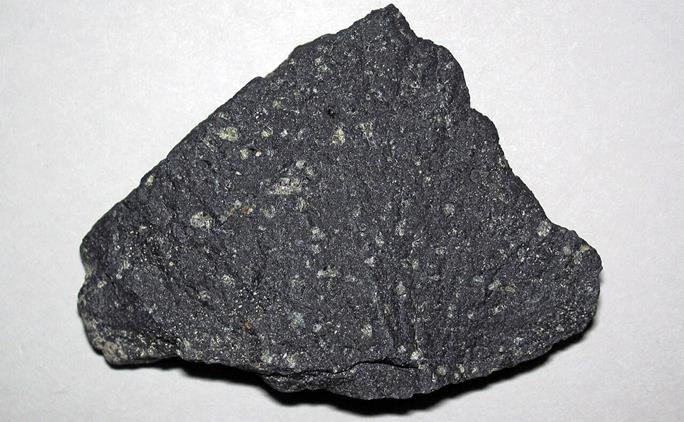There are several basalt rock types and varieties you should know. However, before going to the time, not everyone knows what basalt is. Let us start from the basics.
Basalt is a dark-colored volcanic rock. Volcanic, also called extrusive form on the Earth’s surface. Here, they cool rapidly, forming a fine-grained texture.
A fine-grained or aphanitic texture can occur alongside others, such as porphyritic, with large crystals in a fine-grained groundmass.
Also, these rocks can have a vesicular texture characterized by cavities or vesicles. They form when solidifying magma traps exsolving gas bubbles.
In some, the vesicles are later filled with minerals deposited by fluids after formation, forming amygdaloidal basalts.
Even ophitic and subophitic textures exist where pyroxene or olivine fully or partially surround plagioclase laths, respectively.

What defines a basalt rock?
Basalt rocks are fine-grained, mafic extrusive rocks. Mafic means it is rich in iron and magnesium-rich
These rocks primarily have calcic plagioclase and augite, a clinopyroxene. The calcic plagioclase has more than 50 mol% anorthite. This plagioclase is labradorite to bytownite.
However, they may also have other minerals, including pigeonite or enstatite, olivine, quartz, feldspathoids, alkali feldspar, etc. However, augite is the dominant pyroxene, and quartz doesn’t coexist with feldspathoids.
Furthermore, on the QAPF classification, basalts are fine-grained volcanic rocks in which feldspathoids are no more than 10% and quartz no more than 20% of QAPF content by volume, with plagioclase accounting for more than 65% of total feldspars.
Lastly, basalt is a basic rock whose silica content in basalt is between 45 and 52 wt.%.
Which are the basalt rock types or varieties
You have an idea of what makes a rock basalt. It is time to look at some of the varieties or subtypes.
1. Tholeiitic basalt
Tholeiitic basalts are saturated or oversaturated with silica relative to their alkali oxides and have an extremely fine texture.
Usually, these rocks are poor in sodium, potassium, and aluminum and are relatively higher in silica (about 48-52 wt.%) than alkali basalts.
Phenocrysts in tholeiitic basalt are early-formed plagioclase, colorless to pale-brown iron-poor clinopyroxenes with orthopyroxenes uncommon. Any olivine present occurs as a phenocryst and may show a reaction with orthopyroxenes.
On the other hand, their groundmass has calcium-poor pyroxenes, i.e., enstatite (orthopyroxene) and pigeonite (clinopyroxene). Also, they have normative quartz, and intestinal glass is common, but they don’t have alkali feldspar.
Where are they found? Tholeiitic basalts occur in oceanic crusts, large igneous provinces, mid-ocean ridges, and large layered intrusions.
Lastly, they form from the tholeiitic magma series, which evolve into silica-rich tholeiitic andesites, tachylites, dacite, and rhyolites.
2. Alkali basalts
Alkali basalts are higher in sodium and potassium oxides, i.e., the alkalis, and lower in calcium and iron oxide than other basalts.
Therefore, they will have interstitial normative nepheline or alkali feldspar. Also, since alkali feldspar takes more silica than calcic plagioclase, these rocks are lower in silica, usually 46-48 wt.%.
Phenocrysts in alkali basalts are pleochroic Ti-rich augite and zoned olivine. Also, they may have phlogopite, kaersutite, and orthopyroxenes.
Plagioclase phenocrysts are uncommon but may appear in the late stages, and there may be no orthopyroxene phenocrysts.
On the other hand, the groundmass has olivine, plagioclase, interstitial feldspathoids, alkali feldspar, and rarely glass, with no orthopyroxenes.
Alkali basalts are common in oceanic islands and rifts but can occur in other volcanic fields.
Lastly, when their magma evolves, rocks with nepheline like nepheline syenite and phonolites.
3. High alumina basalts (HABs)
They have at least 17% aluminum oxide (alumina) without counting plagioclase phenocrysts, and their composition lies between alkali and tholeiitic basalts.
High alumina basalts are dominated by plagioclase and augite. Also, they may have olivine phenocrysts, phlogopite, and rarely enstatite or pigeonite.
Note that the term high alumina isn’t specific. It only tells you that the amount of aluminum oxide is high.
Lastly, they occur in the extension between the tholeiite and the alkali province. Some places where they occur include Klyuchevskoy volcano, Kamchatka, Russia, the central parts of Taupo Volcanic Zone, and the Aleutian Islands.
3. Transitional basalts
These kinds lie between alkali and tholeiitic. They evolve into peralkaline rhyolites and trachytes.
These rocks’ augite is calcium-rich. Also, they have plagioclase, olivine, varying alkali feldspar content, and titanomagnetite.
However, they don’t have calcium-poor pyroxenes like pigeonite or enstatite.
4. Trachybasalts
Trachybasalts are basalts high in sodium and potassium oxides, i.e., alkalis exceed 5 wt. %.
These fine-grained volcanic rocks have calcic plagioclase, augite, alkali feldspar, olivine, and minor feldspathoids, usually analcime or leucite.
Olivine basalts
They have a considerable amount of olivine, usually at least 5% by volume. Calcic plagioclase and augite are the dominant minerals.
Primitive or primary basalts
They form from magmas formed from the partial melting of peridotites without evolving or undergoing differentiation.
Note: Picrobasalt
While picrite basalt or picrobasalt may sound like one of the basalt varieties, this rock is ultramafic. Such rocks have less than 45 wt.% silica and more than 90% mafic minerals.
Also, in picrobasalt, olivine phenocrysts are 20-50% by volume, and they may also have interstitial glass and opaque minerals.
Silica-saturated or undersaturated
Considering the silica saturation level, you can classify basalts into silica, oversaturated, undersaturated, or saturated.
Silica oversaturated will have normative quartz, while silica undersaturated have normative feldspathoids.
On the other hand, silica undersaturated lacks enough silica needed to convert all the alkalis to albite or orthoclase. Therefore, they will form some feldspathoids.
Lastly, silica saturated lacks quartz or feldspathoids but has olivine and enstatite.
